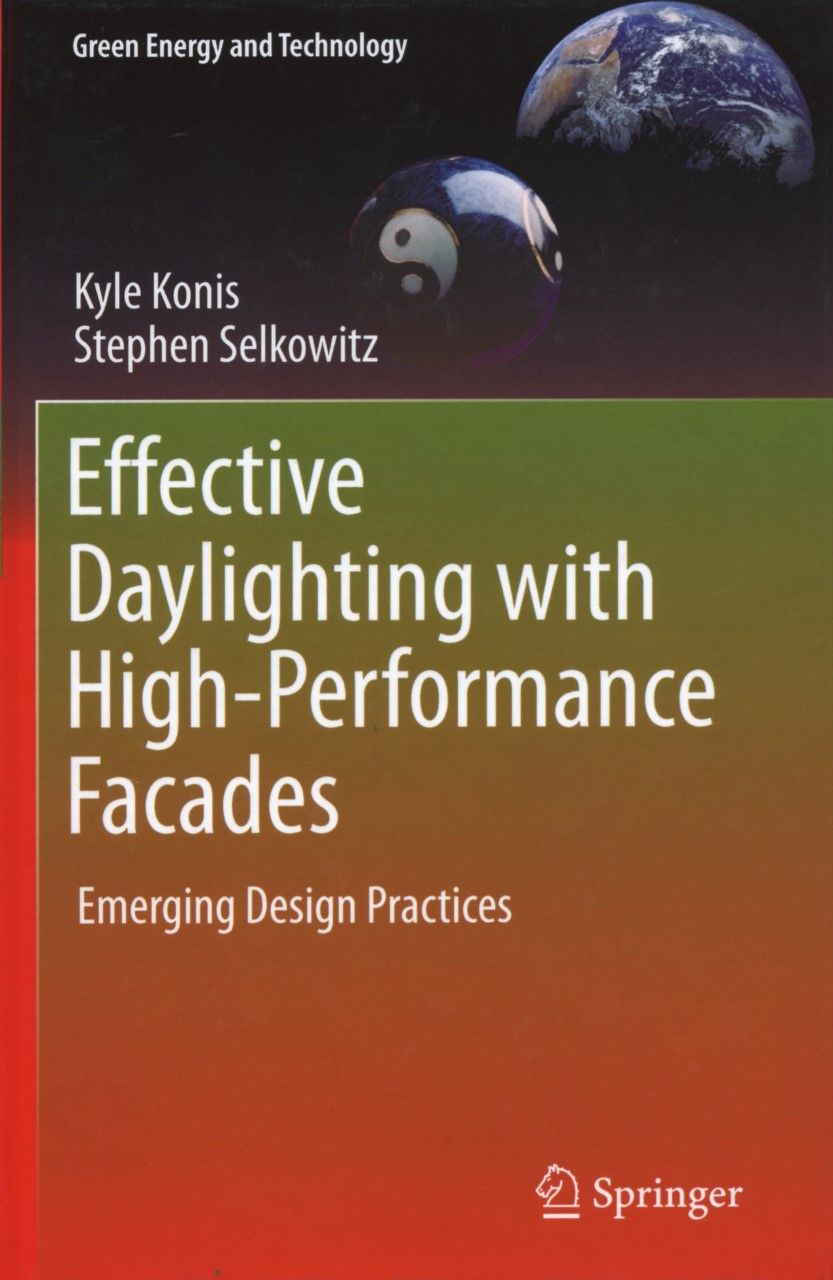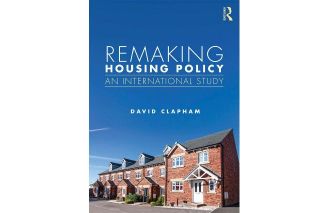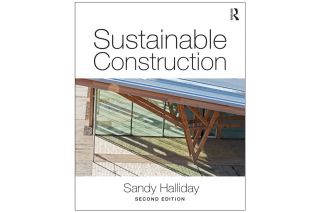
www.buildingsandcities.org/insights/reviews/effective-daylighting-high-performance-facades.html
Effective Daylighting with High-Performance Facades: Emerging Design Practices
Kyle Konis and Stephen Selkowitz. Springer, 2017, ISBN 9783319394619
 Sergio Altomonte (Architecture et Climat, University
of Louvain, Belgium) discusses an important contribution to our theoretical and practical understanding of
daylighting and why it is significant.
Sergio Altomonte (Architecture et Climat, University
of Louvain, Belgium) discusses an important contribution to our theoretical and practical understanding of
daylighting and why it is significant.
Daylight is one of the immutable forces of nature, a primary element that drives the daily and seasonal cycles of our life, the pulse of our activities, giving us life-sustaining visual information while contributing to the creation of meaningful and evocative architectural experiences. For millennia daylighting had an intricate connection to our existence and it continues to play a central role in how we shape and inhabit our spaces. However, we have only recently started to grasp a more complete understanding of daylight's complex role in maintaining our well-being and biological rhythms in sync with the pace of natural patterns, and responding to our needs for luminous and thermal comfort.
Although the daylighting science literature is very vast, a book that comprehensively addresses these many roles of daylight is a rare find, particularly when scientific principles embrace the whole of the design and delivery process of buildings, encompassing at once the modelling of strategies and systems as the validation of performance via on-site monitoring. This is even more significant when such resource can speak with the same effectiveness to the novice and the expert, to the practitioner and the policy-maker. This new book by Kyle Konis and Stephen Selkowitz succeeds in doing 'just' that.
Starting from the initial sections, the reader is gently accompanied by the authors' skilful writing through the most basic principles of daylighting and façade design, presented in their fundamental theoretical aspects. The descriptions are wide-ranging and meticulous, yet without being overwhelming for the unexperienced reader, and are clearly supported by practical examples, appropriate illustrations, and extensive scientific references. The most urgent challenges, and an agenda driving research and practice, are introduced from the onset of the book to form its "leitmotif". In this, particularly interesting is the definition of effectiveness for daylighting. In fact, rather than aiming towards efficiency (a more reductionist term implying the deterministic achievement of a target), the richer framework of daylight effectiveness is presented in terms of the different, and at times competing, values that various stakeholders might give to its performance. This triggers a paradigm shift centred around a transformation from compliance to performance-based design, from static to adaptive and context-aware systems, from theoretical to practical validation, learning and feedback.
Of course, a new design workflow and process delivery centred on effective performance requires novel metrics. This is a relevant task considering the many roles of daylighting and high-performance facades for buildings and their occupants (e.g., light availability, non-visual effects, external views, solar control, thermal comfort, etc.), and the wide range of metrics lately introduced by the most recent developments in computer modelling. Each new metric is presented, exhaustively and rigorously, in its computation and verification aspects (e.g., via software simulation or direct measurements) and is supported by clear graphical explanations. Interestingly, to corroborate this rapidly developing field, the presentation of each metric is concluded by a section on limitations of current approaches and potential future developments.
The theoretical value of the contents presented is high, yet with immediate applicability to the practice of building conception, design and operation. This includes principles for innovating daylighting systems and facade design, accompanied by examples of technological applications. The book illustrates new developments in complex facade systems, describing their computational characteristics and the advanced dynamic components they can integrate. This also encompasses design and operation criteria for control systems that, as part of the move from integrated to interconnected internet of things (IoT) based solutions, are context aware, robust, capable of learning and interoperable with other building components. The authors offer to the reader a wide and detailed overview of current technologies. This provides an outlook on the vast palette of possibilities framed in the context of the trade-offs involved when leveraging effective performance with the specific, and variable, needs of each daylight and facade project.
Performance-based design workflows and tools are presented as part of an iterative process focused on balancing whole-building energy reduction targets with a range of IEQ (indoor environmental qualities) goals. These are defined by explicit and measurable outcomes that also consider programmatic constraints of time and cost. Emerging occupant-centric evaluation methods for improving the feedback loop between design expectations and performance in use are discussed in detail, also addressing the use of physical mock-ups to test alternative solutions. Focus is given to the challenges of robustly modelling occupant behaviour and preferences within current limitations in integrating human factors in design decisions and consequent daylighting and energy performance. The book also describes large-scale commercial low and zero net energy (ZNE) projects in different climates and contextual situations. Although departing from conventional norms, the chosen case studies illustrate how design and building practice are starting to embrace some of the principles illustrated. This includes novel collaborative processes integrating performance-based feedback and project delivery to inform decisions, detailed commissioning practices and post-occupancy evaluations (POEs) to evaluate the fidelity of daylight design intent, and model predictions with measured energy data and occupant feedback.
In essence, this book by Konis and Selkowitz is a precious resource responding to the needs of a wide-ranging audience. The authors are to be applauded for providing a rare compendium of knowledge that is well-written, easily accessible but also technically sound, supported by detailed and appropriate graphics that make the reading pleasurable, informative, and evidently relevant to both scientific research and practical applications.
Latest Peer-Reviewed Journal Content
Acceptability of sufficiency consumption policies by Finnish households
E Nuorivaara & S Ahvenharju
Key factors for revitalising heritage buildings through adaptive reuse
É Savoie, J P Sapinski & A-M Laroche
Cooler streets for a cycleable city: assessing policy alignment
C Tang & J Bush
Understanding the embodied carbon credentials of modern methods of construction
R O'Hegarty, A McCarthy, J O'Hagan, T Thanapornpakornsin, S Raffoul & O Kinnane
The changing typology of urban apartment buildings in Aurinkolahti
S Meriläinen & A Tervo
Embodied climate impacts in urban development: a neighbourhood case study
S Sjökvist, N Francart, M Balouktsi & H Birgisdottir
Environmental effects of urban wind energy harvesting: a review
I Tsionas, M laguno-Munitxa & A Stephan
Office environment and employee differences by company health management certification
S Arata, M Sugiuchi, T Ikaga, Y Shiraishi, T Hayashi, S Ando & S Kawakubo
Spatiotemporal evaluation of embodied carbon in urban residential development
I Talvitie, A Amiri & S Junnila
Energy sufficiency in buildings and cities: current research, future directions [editorial]
M Sahakian, T Fawcett & S Darby
Sufficiency, consumption patterns and limits: a survey of French households
J Bouillet & C Grandclément
Health inequalities and indoor environments: research challenges and priorities [editorial]
M Ucci & A Mavrogianni
Operationalising energy sufficiency for low-carbon built environments in urbanising India
A B Lall & G Sethi
Promoting practices of sufficiency: reprogramming resource-intensive material arrangements
T H Christensen, L K Aagaard, A K Juvik, C Samson & K Gram-Hanssen
Culture change in the UK construction industry: an anthropological perspective
I Tellam
Are people willing to share living space? Household preferences in Finland
E Ruokamo, E Kylkilahti, M Lettenmeier & A Toppinen
Towards urban LCA: examining densification alternatives for a residential neighbourhood
M Moisio, E Salmio, T Kaasalainen, S Huuhka, A Räsänen, J Lahdensivu, M Leppänen & P Kuula
A population-level framework to estimate unequal exposure to indoor heat and air pollution
R Cole, C H Simpson, L Ferguson, P Symonds, J Taylor, C Heaviside, P Murage, H L Macintyre, S Hajat, A Mavrogianni & M Davies
Finnish glazed balconies: residents' experience, wellbeing and use
L Jegard, R Castaño-Rosa, S Kilpeläinen & S Pelsmakers
Modelling Nigerian residential dwellings: bottom-up approach and scenario analysis
C C Nwagwu, S Akin & E G Hertwich
Mapping municipal land policies: applications of flexible zoning for densification
V Götze, J-D Gerber & M Jehling
Energy sufficiency and recognition justice: a study of household consumption
A Guilbert
Linking housing, socio-demographic, environmental and mental health data at scale
P Symonds, C H Simpson, G Petrou, L Ferguson, A Mavrogianni & M Davies
Measuring health inequities due to housing characteristics
K Govertsen & M Kane
Provide or prevent? Exploring sufficiency imaginaries within Danish systems of provision
L K Aagaard & T H Christensen
Imagining sufficiency through collective changes as satisfiers
O Moynat & M Sahakian
US urban land-use reform: a strategy for energy sufficiency
Z M Subin, J Lombardi, R Muralidharan, J Korn, J Malik, T Pullen, M Wei & T Hong
Mapping supply chains for energy retrofit
F Wade & Y Han
Operationalising building-related energy sufficiency measures in SMEs
I Fouiteh, J D Cabrera Santelices, A Susini & M K Patel
Promoting neighbourhood sharing: infrastructures of convenience and community
A Huber, H Heinrichs & M Jaeger-Erben
New insights into thermal comfort sufficiency in dwellings
G van Moeseke, D de Grave, A Anciaux, J Sobczak & G Wallenborn
'Rightsize': a housing design game for spatial and energy sufficiency
P Graham, P Nourian, E Warwick & M Gath-Morad
Implementing housing policies for a sufficient lifestyle
M Bagheri, L Roth, L Siebke, C Rohde & H-J Linke
The jobs of climate adaptation
T Denham, L Rickards & O Ajulo
Structural barriers to sufficiency: the contribution of research on elites
M Koch, K Emilsson, J Lee & H Johansson
Disrupting the imaginaries of urban action to deliver just adaptation [editorial]
V Castán-Broto, M Olazabal & G Ziervogel
Nature for resilience reconfigured: global- to-local translation of frames in Africa
K Rochell, H Bulkeley & H Runhaar
How hegemonic discourses of sustainability influence urban climate action
V Castán Broto, L Westman & P Huang
Fabric first: is it still the right approach?
N Eyre, T Fawcett, M Topouzi, G Killip, T Oreszczyn, K Jenkinson & J Rosenow
Social value of the built environment [editorial]
F Samuel & K Watson
Understanding demolition [editorial]
S Huuhka
Data politics in the built environment [editorial]
A Karvonen & T Hargreaves



Latest Commentaries
Decolonising Cities: The Role of Street Naming
During colonialisation, street names were drawn from historical and societal contexts of the colonisers. Street nomenclature deployed by colonial administrators has a role in legitimising historical narratives and decentring local languages, cultures and heritage. Buyana Kareem examines street renaming as an important element of decolonisation.
Integrating Nature into Cities
Increasing vegetation and green and blue spaces in cities can support both climate change mitigation and adaptation goals, while also enhancing biodiversity and ecological health. Maibritt Pedersen Zari (Auckland University of Technology) explains why nature-based solutions (NbS) must be a vital part of urban planning and design.